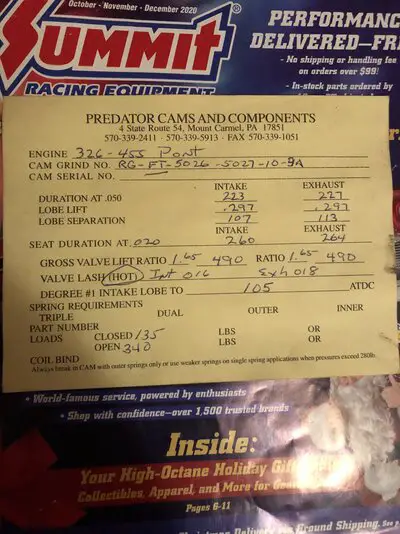Looking for opinions from some of the Pontiac guys out there about stock camshafts. My FIL came to me a few weeks ago and decided he wants an old car to drive when it's nice out and said he wants to get my 71 LeMans sport running again and he will pay for the original 350 engine to be rebuilt. Now please don't tell me to just go with a 400 or a 455, I already tried that and said I have a 455 we could use but he just wasn't having it. Can't say I blame him as I was always sorta leaning towards using the 350 since it is a numbers matching 4 speed car. But the plan was always to upgrade it a bit. Mostly by ditching the 2bbl in favor of a Qjet raising the compression with and older set of heads and upgrading the cam.
So here's what I'm working with.
A 71 Pontiac 350 2bbl with #94 heads that has an advertised zip ratio of 8:1
I have a set of 69 #47 heads that should get me to 9:1. My plan was to go with an 068 cam since it is a 4 speed (muncie M20) and it has 3.23 gears out back.
I also will be using an 71 cast iron intake and a vintage correct Pontiac Qjet 7029263.
Now the question is would the 068 be too much for a 350 with about 9:1 or would I be better with an 066 ? I know that in 69 the 350 HO used an 068 with a manual transmission but they were 10.5:1. What say the Pontiac gurus?
So here's what I'm working with.
A 71 Pontiac 350 2bbl with #94 heads that has an advertised zip ratio of 8:1
I have a set of 69 #47 heads that should get me to 9:1. My plan was to go with an 068 cam since it is a 4 speed (muncie M20) and it has 3.23 gears out back.
I also will be using an 71 cast iron intake and a vintage correct Pontiac Qjet 7029263.
Now the question is would the 068 be too much for a 350 with about 9:1 or would I be better with an 066 ? I know that in 69 the 350 HO used an 068 with a manual transmission but they were 10.5:1. What say the Pontiac gurus?


